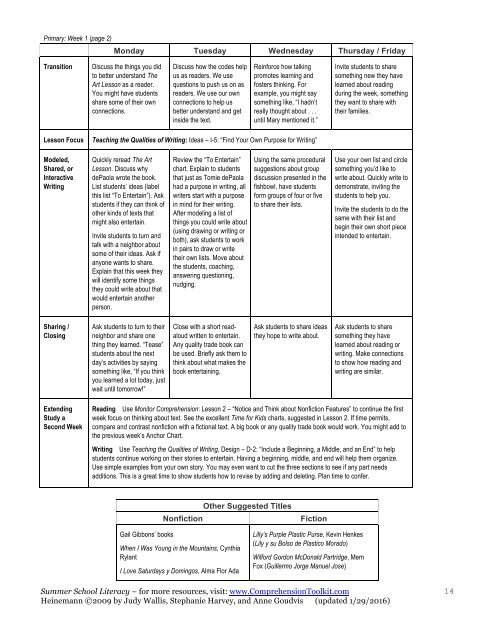Summer School Literacy Pacing Guide
SummerSchoolLiteracy
SummerSchoolLiteracy
You also want an ePaper? Increase the reach of your titles
YUMPU automatically turns print PDFs into web optimized ePapers that Google loves.
Primary: Week 1 (page 2)<br />
Monday Tuesday Wednesday Thursday / Friday<br />
Transition<br />
Discuss the things you did<br />
to better understand The<br />
Art Lesson as a reader.<br />
You might have students<br />
share some of their own<br />
connections.<br />
Discuss how the codes help<br />
us as readers. We use<br />
questions to push us on as<br />
readers. We use our own<br />
connections to help us<br />
better understand and get<br />
inside the text.<br />
Reinforce how talking<br />
promotes learning and<br />
fosters thinking. For<br />
example, you might say<br />
something like, “I hadn’t<br />
really thought about . . .<br />
until Mary mentioned it.”<br />
Invite students to share<br />
something new they have<br />
learned about reading<br />
during the week, something<br />
they want to share with<br />
their families.<br />
Lesson Focus<br />
Teaching the Qualities of Writing: Ideas – I-5: “Find Your Own Purpose for Writing”<br />
Modeled,<br />
Shared, or<br />
Interactive<br />
Writing<br />
Quickly reread The Art<br />
Lesson. Discuss why<br />
dePaola wrote the book.<br />
List students’ ideas (label<br />
this list “To Entertain”). Ask<br />
students if they can think of<br />
other kinds of texts that<br />
might also entertain.<br />
Invite students to turn and<br />
talk with a neighbor about<br />
some of their ideas. Ask if<br />
anyone wants to share.<br />
Explain that this week they<br />
will identify some things<br />
they could write about that<br />
would entertain another<br />
person.<br />
Review the “To Entertain”<br />
chart. Explain to students<br />
that just as Tomie dePaola<br />
had a purpose in writing, all<br />
writers start with a purpose<br />
in mind for their writing.<br />
After modeling a list of<br />
things you could write about<br />
(using drawing or writing or<br />
both), ask students to work<br />
in pairs to draw or write<br />
their own lists. Move about<br />
the students, coaching,<br />
answering questioning,<br />
nudging.<br />
Using the same procedural<br />
suggestions about group<br />
discussion presented in the<br />
fishbowl, have students<br />
form groups of four or five<br />
to share their lists.<br />
Use your own list and circle<br />
something you’d like to<br />
write about. Quickly write to<br />
demonstrate, inviting the<br />
students to help you.<br />
Invite the students to do the<br />
same with their list and<br />
begin their own short piece<br />
intended to entertain.<br />
Sharing /<br />
Closing<br />
Ask students to turn to their<br />
neighbor and share one<br />
thing they learned. “Tease”<br />
students about the next<br />
day’s activities by saying<br />
something like, “If you think<br />
you learned a lot today, just<br />
wait until tomorrow!”<br />
Close with a short readaloud<br />
written to entertain.<br />
Any quality trade book can<br />
be used. Briefly ask them to<br />
think about what makes the<br />
book entertaining.<br />
Ask students to share ideas<br />
they hope to write about.<br />
Ask students to share<br />
something they have<br />
learned about reading or<br />
writing. Make connections<br />
to show how reading and<br />
writing are similar.<br />
Extending<br />
Study a<br />
Second Week<br />
Reading Use Monitor Comprehension: Lesson 2 – “Notice and Think about Nonfiction Features” to continue the first<br />
week focus on thinking about text. See the excellent Time for Kids charts, suggested in Lesson 2. If time permits,<br />
compare and contrast nonfiction with a fictional text. A big book or any quality trade book would work. You might add to<br />
the previous week’s Anchor Chart.<br />
Writing Use Teaching the Qualities of Writing, Design – D-2: “Include a Beginning, a Middle, and an End” to help<br />
students continue working on their stories to entertain. Having a beginning, middle, and end will help them organize.<br />
Use simple examples from your own story. You may even want to cut the three sections to see if any part needs<br />
additions. This is a great time to show students how to revise by adding and deleting. Plan time to confer.<br />
Nonfiction<br />
Other Suggested Titles<br />
Fiction<br />
Gail Gibbons’ books<br />
When I Was Young in the Mountains, Cynthia<br />
Rylant<br />
I Love Saturdays y Domingos, Alma Flor Ada<br />
Lilly’s Purple Plastic Purse, Kevin Henkes<br />
(Lily y su Bolso de Plastico Morado)<br />
Wilford Gordon McDonald Partridge, Mem<br />
Fox (Guillermo Jorge Manuel Jose)<br />
<strong>Summer</strong> <strong>School</strong> <strong>Literacy</strong> – for more resources, visit: www.ComprehensionToolkit.com<br />
Heinemann ©2009 by Judy Wallis, Stephanie Harvey, and Anne Goudvis (updated 1/29/2016)<br />
14


